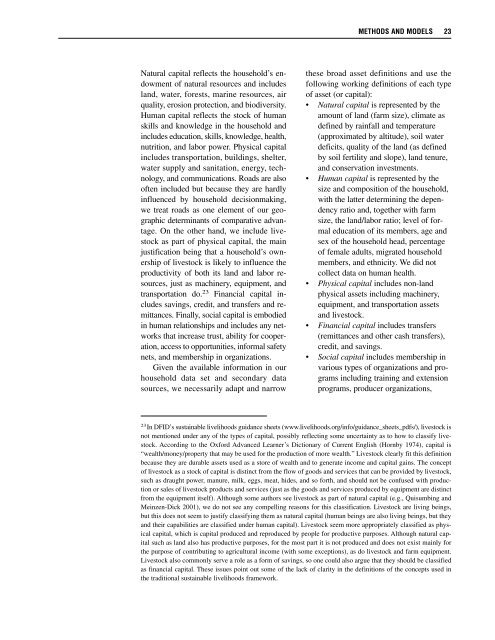Rural Development Policies and Sustainable Land Use in the ...
Rural Development Policies and Sustainable Land Use in the ...
Rural Development Policies and Sustainable Land Use in the ...
Create successful ePaper yourself
Turn your PDF publications into a flip-book with our unique Google optimized e-Paper software.
METHODS AND MODELS 23<br />
Natural capital reflects <strong>the</strong> household’s endowment<br />
of natural resources <strong>and</strong> <strong>in</strong>cludes<br />
l<strong>and</strong>, water, forests, mar<strong>in</strong>e resources, air<br />
quality, erosion protection, <strong>and</strong> biodiversity.<br />
Human capital reflects <strong>the</strong> stock of human<br />
skills <strong>and</strong> knowledge <strong>in</strong> <strong>the</strong> household <strong>and</strong><br />
<strong>in</strong>cludes education, skills, knowledge, health,<br />
nutrition, <strong>and</strong> labor power. Physical capital<br />
<strong>in</strong>cludes transportation, build<strong>in</strong>gs, shelter,<br />
water supply <strong>and</strong> sanitation, energy, technology,<br />
<strong>and</strong> communications. Roads are also<br />
often <strong>in</strong>cluded but because <strong>the</strong>y are hardly<br />
<strong>in</strong>fluenced by household decisionmak<strong>in</strong>g,<br />
we treat roads as one element of our geographic<br />
determ<strong>in</strong>ants of comparative advantage.<br />
On <strong>the</strong> o<strong>the</strong>r h<strong>and</strong>, we <strong>in</strong>clude livestock<br />
as part of physical capital, <strong>the</strong> ma<strong>in</strong><br />
justification be<strong>in</strong>g that a household’s ownership<br />
of livestock is likely to <strong>in</strong>fluence <strong>the</strong><br />
productivity of both its l<strong>and</strong> <strong>and</strong> labor resources,<br />
just as mach<strong>in</strong>ery, equipment, <strong>and</strong><br />
transportation do. 23 F<strong>in</strong>ancial capital <strong>in</strong>cludes<br />
sav<strong>in</strong>gs, credit, <strong>and</strong> transfers <strong>and</strong> remittances.<br />
F<strong>in</strong>ally, social capital is embodied<br />
<strong>in</strong> human relationships <strong>and</strong> <strong>in</strong>cludes any networks<br />
that <strong>in</strong>crease trust, ability for cooperation,<br />
access to opportunities, <strong>in</strong>formal safety<br />
nets, <strong>and</strong> membership <strong>in</strong> organizations.<br />
Given <strong>the</strong> available <strong>in</strong>formation <strong>in</strong> our<br />
household data set <strong>and</strong> secondary data<br />
sources, we necessarily adapt <strong>and</strong> narrow<br />
<strong>the</strong>se broad asset def<strong>in</strong>itions <strong>and</strong> use <strong>the</strong><br />
follow<strong>in</strong>g work<strong>in</strong>g def<strong>in</strong>itions of each type<br />
of asset (or capital):<br />
• Natural capital is represented by <strong>the</strong><br />
amount of l<strong>and</strong> (farm size), climate as<br />
def<strong>in</strong>ed by ra<strong>in</strong>fall <strong>and</strong> temperature<br />
(approximated by altitude), soil water<br />
deficits, quality of <strong>the</strong> l<strong>and</strong> (as def<strong>in</strong>ed<br />
by soil fertility <strong>and</strong> slope), l<strong>and</strong> tenure,<br />
<strong>and</strong> conservation <strong>in</strong>vestments.<br />
• Human capital is represented by <strong>the</strong><br />
size <strong>and</strong> composition of <strong>the</strong> household,<br />
with <strong>the</strong> latter determ<strong>in</strong><strong>in</strong>g <strong>the</strong> dependency<br />
ratio <strong>and</strong>, toge<strong>the</strong>r with farm<br />
size, <strong>the</strong> l<strong>and</strong>/labor ratio; level of formal<br />
education of its members, age <strong>and</strong><br />
sex of <strong>the</strong> household head, percentage<br />
of female adults, migrated household<br />
members, <strong>and</strong> ethnicity. We did not<br />
collect data on human health.<br />
• Physical capital <strong>in</strong>cludes non-l<strong>and</strong><br />
physical assets <strong>in</strong>clud<strong>in</strong>g mach<strong>in</strong>ery,<br />
equipment, <strong>and</strong> transportation assets<br />
<strong>and</strong> livestock.<br />
• F<strong>in</strong>ancial capital <strong>in</strong>cludes transfers<br />
(remittances <strong>and</strong> o<strong>the</strong>r cash transfers),<br />
credit, <strong>and</strong> sav<strong>in</strong>gs.<br />
• Social capital <strong>in</strong>cludes membership <strong>in</strong><br />
various types of organizations <strong>and</strong> programs<br />
<strong>in</strong>clud<strong>in</strong>g tra<strong>in</strong><strong>in</strong>g <strong>and</strong> extension<br />
programs, producer organizations,<br />
23<br />
In DFID’s susta<strong>in</strong>able livelihoods guidance sheets (www.livelihoods.org/<strong>in</strong>fo/guidance_sheets_pdfs/), livestock is<br />
not mentioned under any of <strong>the</strong> types of capital, possibly reflect<strong>in</strong>g some uncerta<strong>in</strong>ty as to how to classify livestock.<br />
Accord<strong>in</strong>g to <strong>the</strong> Oxford Advanced Learner’s Dictionary of Current English (Hornby 1974), capital is<br />
“wealth/money/property that may be used for <strong>the</strong> production of more wealth.” Livestock clearly fit this def<strong>in</strong>ition<br />
because <strong>the</strong>y are durable assets used as a store of wealth <strong>and</strong> to generate <strong>in</strong>come <strong>and</strong> capital ga<strong>in</strong>s. The concept<br />
of livestock as a stock of capital is dist<strong>in</strong>ct from <strong>the</strong> flow of goods <strong>and</strong> services that can be provided by livestock,<br />
such as draught power, manure, milk, eggs, meat, hides, <strong>and</strong> so forth, <strong>and</strong> should not be confused with production<br />
or sales of livestock products <strong>and</strong> services (just as <strong>the</strong> goods <strong>and</strong> services produced by equipment are dist<strong>in</strong>ct<br />
from <strong>the</strong> equipment itself). Although some authors see livestock as part of natural capital (e.g., Quisumb<strong>in</strong>g <strong>and</strong><br />
Me<strong>in</strong>zen-Dick 2001), we do not see any compell<strong>in</strong>g reasons for this classification. Livestock are liv<strong>in</strong>g be<strong>in</strong>gs,<br />
but this does not seem to justify classify<strong>in</strong>g <strong>the</strong>m as natural capital (human be<strong>in</strong>gs are also liv<strong>in</strong>g be<strong>in</strong>gs, but <strong>the</strong>y<br />
<strong>and</strong> <strong>the</strong>ir capabilities are classified under human capital). Livestock seem more appropriately classified as physical<br />
capital, which is capital produced <strong>and</strong> reproduced by people for productive purposes. Although natural capital<br />
such as l<strong>and</strong> also has productive purposes, for <strong>the</strong> most part it is not produced <strong>and</strong> does not exist ma<strong>in</strong>ly for<br />
<strong>the</strong> purpose of contribut<strong>in</strong>g to agricultural <strong>in</strong>come (with some exceptions), as do livestock <strong>and</strong> farm equipment.<br />
Livestock also commonly serve a role as a form of sav<strong>in</strong>gs, so one could also argue that <strong>the</strong>y should be classified<br />
as f<strong>in</strong>ancial capital. These issues po<strong>in</strong>t out some of <strong>the</strong> lack of clarity <strong>in</strong> <strong>the</strong> def<strong>in</strong>itions of <strong>the</strong> concepts used <strong>in</strong><br />
<strong>the</strong> traditional susta<strong>in</strong>able livelihoods framework.
















